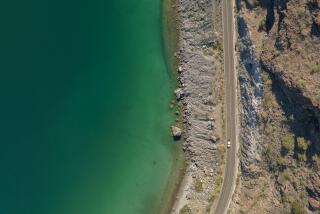Grunion Make Their Annual Run but Hunt Turns Into a Washout
- Share via
Each March, when the moon and the tides are just right, hundreds of people gather on Southern California beaches to wriggle their toes in the sand, stare out at the dark sea and participate in a peculiar nocturnal rite of spring: the greeting of the grunion.
The grunion--slithery, silvery little fish that mate only on the shores of sandy beaches from Santa Barbara to Baja California--returned this week.
At the Cabrillo Marine Museum in San Pedro, which has made grunion hunting a specialty, that is cause for celebration. But--as a crowd of about 80 participating in the museum’s “Meet the Grunion” program discovered Monday night--the grunion are elusive.
Peculiar Trait
“This could only happen in Southern California,” quipped Elaine Theiss of Bellflower, who attended the museum program after four unsuccessful solo attempts to see grunion. “A bunch of adults all standing around waiting for fish to do their thing.”
And wait they did.
What they were waiting for were 4-to-6-inch-long fish that look like smelts, although they are actually members of the silversides family, according to Patrick Moore of the state Department of Fish and Game. The name grunion, derived from Spanish, is loosely translated to mean “the grunter,” a moniker that stems from the little squeak the creatures give off when they reach the beach.
The grunion have no particular affinity for any one beach, although experts say that for some unknown reason they show up with the most regularity at Cabrillo Beach. Though the moon and tides help predict the time they will arrive, no one knows precisely where they will come ashore.
Between March and August, when the tides are at their highest during the several nights that follow the full or the new moon, the grunion hover off the Southern California coast. Around high tide, a few male scouts come ashore to check out the beach.
If the beach is sandy (the grunion do not like rocks) and everything seems safe--that is, if crazy humans are not shining bright flashlights or making a lot of noise--the scouts swim back out and give the thumbs-up sign to the rest of the grunion.
Like a scene from a bad horror movie, the fish then swarm the beach by the thousands, as Theiss said, “to do their thing.” More commonly, this is called a grunion run.
Mating Ritual
During mating, the females burrow their tails into the sand until just their heads stick out and then deposit their eggs--as many as 3,000 at a time. The males, two and three at once, wrap their bodies around the females and deposit their milt, which slides down to fertilize the eggs.
The female then jerks her body free, and all the grunion catch the next wave out.
If the humans are lucky, they can scoop up the grunion during the brief mating process, although California law gives the grunion a decided advantage. April and May are closed season, because that is the heaviest spawning period. Grunion hunters who are older than 15 must have a fishing license, and the slippery grunion may be caught only with bare hands.
“You can’t use pan lids or Frisbees or blankets or big holes in the sand to catch them,” Moore said. “It’s considered sporting to give them an opportunity.”
Because grunion are classified as game animals, they may not be served in restaurants. Grunion aficionados say they taste best breaded in cornmeal and fried until golden brown, although some people break them apart and sprinkle them over salads.
“They’re good for a light lunch,” Moore said, “on a summer afternoon with salad and soda crackers, light wine or iced tea.”
Others, however, are not so convinced. “They’re bony and they’re oily and they’re not particularly tasty,” said Marilyn Marrs, who volunteers for the Cabrillo Marine Museum during grunion runs. “If you’re into anchovies, you can eat these guys with no problem.”
So what is it about the grunion that captivates Southern Californians so?
“It’s like a miracle,” said Irene Ng of Montebello who took her parents, visiting from Hong Kong, to Cabrillo Beach on Monday night. “This is my fourth time. I bring my friends and my relatives. It’s a way to appreciate the creation of God.”
“You have to come see it,” said Larry Fukuhara, program coordinator for the museum. “And once you see it, you watch these things writhing on the beach, you’ll want to come again.”
The museum program, which has been running since 1951 and includes a lecture and film about grunion, is apparently the only one of its kind, according to state and local officials. Faculty at the Scripps Institute of Oceanography in San Diego used to conduct annual grunion outings, but spokesman Chuck Colgan said that “to wait until 1 in the morning to do a grunion run and then not have any show up” was not exactly their idea of a good time.
That attitude, however, did not prevail Monday among those at Cabrillo Beach--who waited for more than an hour in the chilly night air to see grunion. Couples cuddled for warmth, children drew fish in the sand and people who had never before met conversed like old friends. Museum officials, meanwhile, scoured the beach in search of scouts. At midnight, narrator George Van Doren sent the disappointed crowd home.
“Folks,” Van Doren said, “we were victims of the grunion.”
Victims indeed. The grunion showed up an hour and a half later.
More to Read
Sign up for The Wild
We’ll help you find the best places to hike, bike and run, as well as the perfect silent spots for meditation and yoga.
You may occasionally receive promotional content from the Los Angeles Times.






